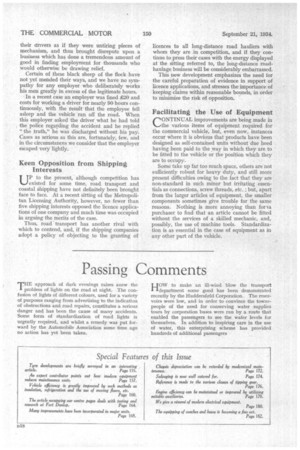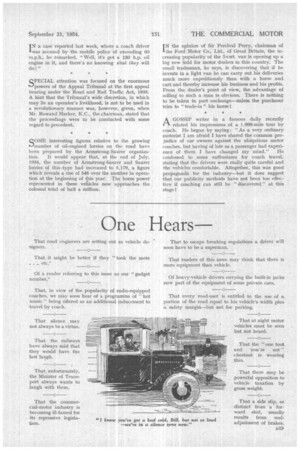Passing Comments
Page 76

Page 77

If you've noticed an error in this article please click here to report it so we can fix it.
THE approach of dark evenings raises anew the problem of lights on the road at night. The confusion of lights of different colours, used for a variety of purposes ranging from advertising to the indication of obstructions and road repairs, constitutes a serious danger and has been the cause of many accidents. Some form of standardization of road lights is urgently required, and whilst a remedy was put forward by the Automobile Association some time ago no action has yet been taken.
1_10W to make an ill-wind blow the transport 'department some good has been demonstrated recently by the Huddersfield Corporation. The reservoirs were low, and in order to convince the townspeople of the need for conserving water supplies tours by corporation buses were run by a route that enabled the passengers to see the water levels for themselves, In addition to inspiring care in the use of water, this enterprising scheme has provided hundreds of additional passengers
IN a case reported last week, where a coach driver lwas accused by the mobile police of eiceeding 60 m.p.h., he remarked, "Well, it's got a 130 h.p. oil engine in it, and there's no knowing Oat they will do!"
SPECIAL attention was focused on the enormous powers of the Appeal Tribunal at the first appeal hearing under the Road and Rail Traffic Act, 1933. A hint that the Tribunal's wide discretion, in which may he an operator's livelihood, is not to be used in a revolutionary manner was, however, given, when Mr. Rowand Harker, K.C., the chairman, stated that the proceedings were to be conducted with some regard to precedent.
SOME interesting figures relative to the growing number of oil-engined lorries on the road have been prepared by the Armstrong-Satirer organiza tion. It would appear that, at the end of July, 3934, the number of Armstrong-Saurer and Samrer lorries of this,type had increased to 5,179, a figure which reveals a rise of 546 over the number in operation at the beginning of this year. The horse power represented in these vehicles now approaches the colossal total of hall a million.
IN the opinion of Sir Percival Perry, chairman of Ithe Ford Motor Co., Ltd.., Of Great Britain, the in. creasing popularity of the 5-cwt. van is opening up a big new field for motor dealers in this country. The small tradesman, he says, is discovering that if he invests in a light van he can carry out his deliveries much more expeditiously than with a horse . and cart and thereby increase his business and his profits. From the dealer's point of view, the advantage of selling to such a man is obvious. There is nothing to be taken in part exchange—unless the purchaser tries to " trade-in " his horse!
AGOSSIP writer in a famous daily recently related his impressions of a 1,000-mile tour by coach. He began by saying; "As a very ordinary motorist I am afraid I have shared the common prejudice of car owners against the ubiquitous motor coaches, but having of late as a passenger had experience of them I have changed my mind." He confessed to some enthusiasm for coach travel; stating that the drivers were really quite careful and the vehicles comfortable. Altogether, this was good propaganda for the industry—but it does suggest that our publicity methods have not been too effective if coaching can still be " discovered" at this stage I








































































































































































